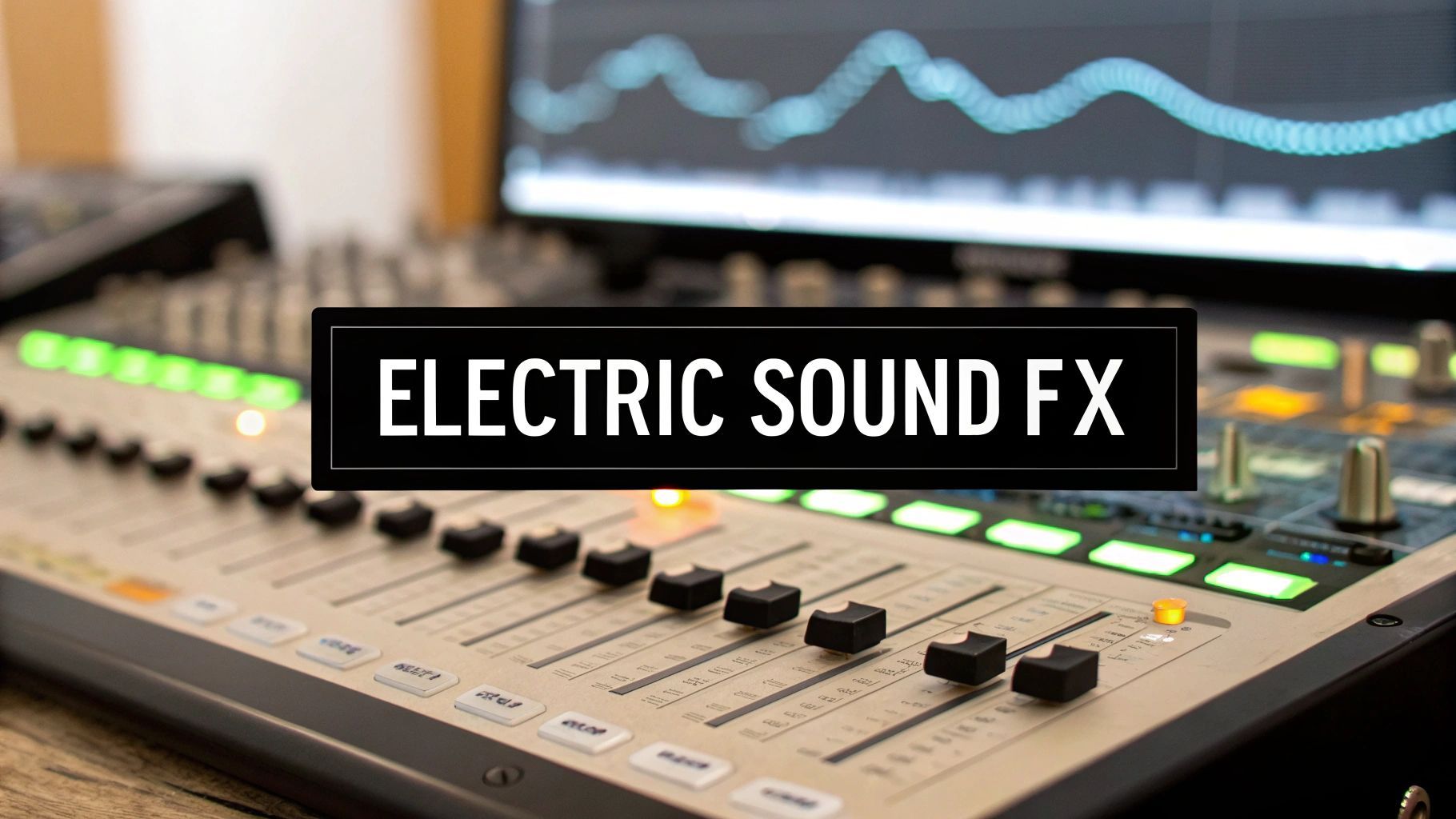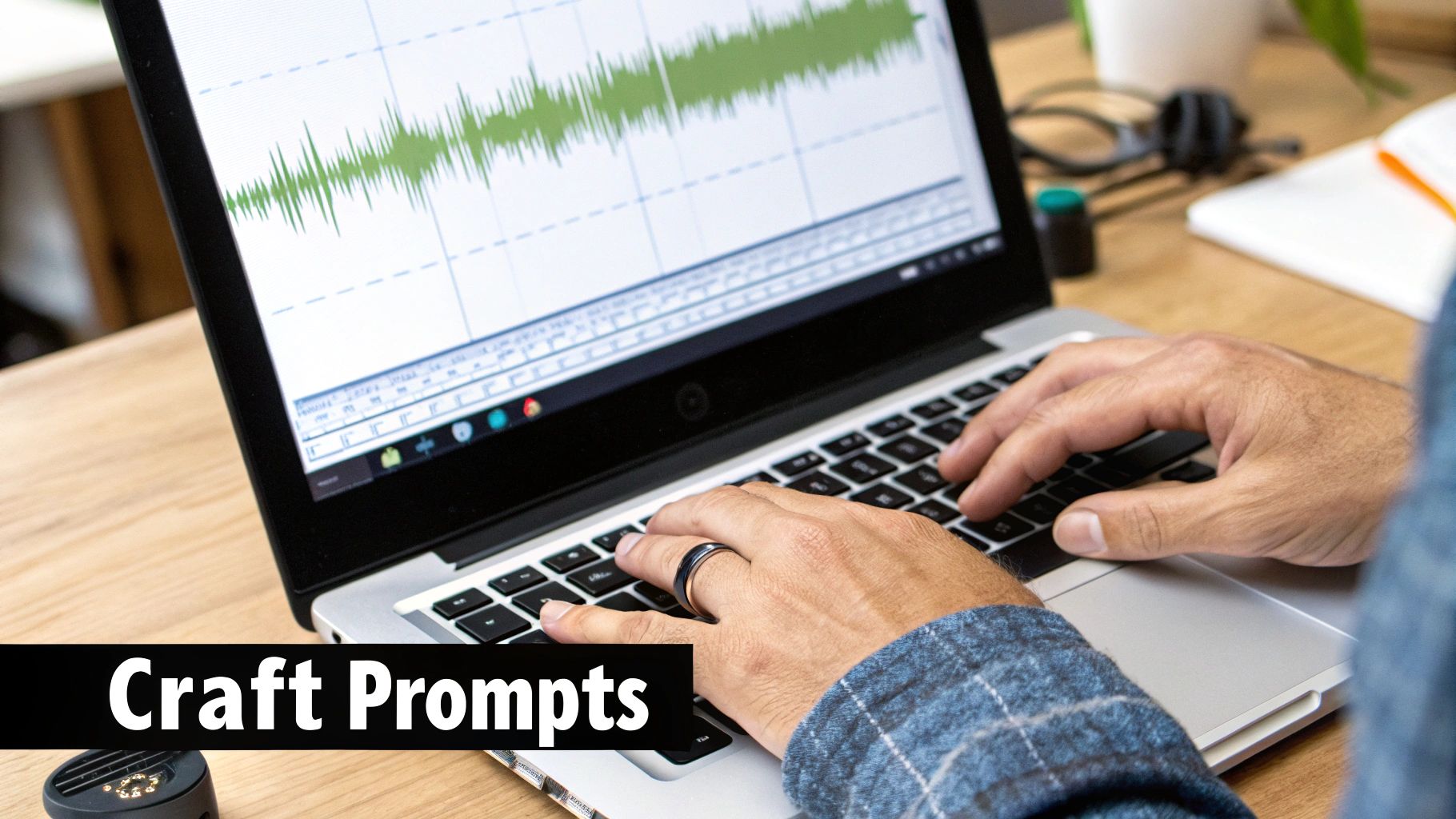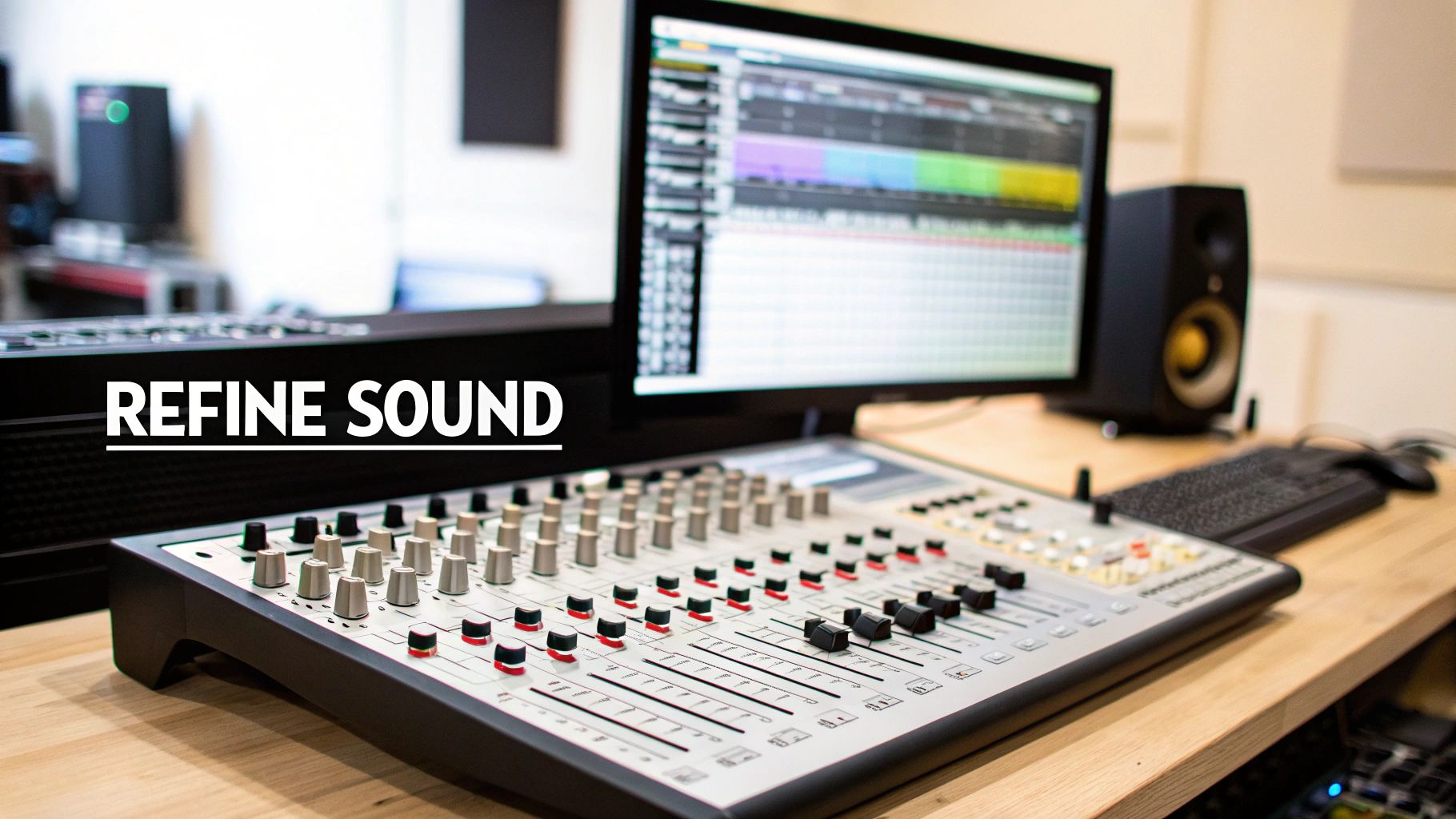
When you think of an electric sound effect, what comes to mind? It could be anything from the quiet hum of a powered-up computer to a massive, dramatic electrical arc. These sounds are all about capturing the energy of electricity, and with a tool like SFX Engine, you can craft everything from a simple static crackle to a futuristic power surge using just a few descriptive words.

Jumping into a new tool can sometimes feel like staring at a complex circuit board, but creating your first electric sound effect is really about translating your idea into the right language. The trick is to ditch generic prompts and start thinking like a storyteller.
Instead of just typing "spark," try to paint a picture with your words. What does that spark sound like in its environment? Imagine something like, 'a short, sharp crackle of static electricity from a failing neon sign.' See the difference? That level of specificity gives the AI concrete details to work with, which almost always leads to a richer, more authentic sound.
The secret to getting SFX Engine to generate the sound you hear in your head is to use vivid, action-oriented language. Think of your prompt as the blueprint for your final audio—the better the blueprint, the better the result.
When you're writing your initial prompt, try to include these kinds of details:
This approach immediately gets you beyond simple zaps and starts you on the path to crafting complex electrical storms or subtle, ambient hums.
A great sound effect tells a story in an instant. Your prompt is the opening line of that story, giving the AI a clear narrative to follow.
Before you even write the prompt, think about the emotion or atmosphere you're trying to build. Is the sound meant to be menacing, a clear sign of danger from a live wire? Or is it a steady, reassuring hum from a well-oiled machine? Your word choices will directly shape that outcome.
This kind of foundational thinking is a huge part of the craft, and you can dive deeper into the core principles of what is sound design in our detailed guide. Honestly, mastering that creative leap from a vague concept to a killer prompt is the most important first step you'll take.

This is where the magic happens. The real power of SFX Engine lies in how you talk to it. Moving beyond simple guesswork and developing a framework for your prompts is what separates a decent sound from the perfect one.
The trick is to think in categories. Are you after the steady, low-frequency thrum of a futuristic power core, or do you need the violent, intermittent crackle of a damaged high-voltage transformer arcing wildly? Each of these ideas requires a completely different vocabulary to get the AI pointed in the right direction.
Vague prompts are the enemy of great sound design. Just typing "electric sound" will probably get you a generic, muddy buzz that isn't useful for much. To get around this, you need to start layering your prompts with details that paint a full picture for the AI.
I find it helps to think about it in these terms:
For instance, "electrical spark" is a pretty weak prompt. But what if we change it to: "A short, sharp, high-frequency crackle of static electricity from a failing neon sign in an alleyway." See the difference? Now the AI has texture, action, and context to work with, which almost always yields a more specific and usable sound effect.
Remember, the AI takes your words quite literally. The more sensory detail you feed it, the less you'll have to rely on luck to get the perfect sound. This approach is key when you want to create sound effects online with any kind of precision.
To really see this in action, let's compare a few different prompt approaches for common electric effects.
This table shows how just a little more thought and detail in your prompt can dramatically change the outcome.
| Sound Effect Goal | Weak Prompt Example | Strong Prompt Example | Expected Outcome |
|---|---|---|---|
| Sci-Fi Weapon Charge | laser charging | A deep, resonant, low-frequency hum of a plasma rifle charging, with a rising pitch and crackling energy building to a peak | A dynamic sound with movement and texture, perfect for a weapon power-up sequence. |
| Damaged Equipment | broken wire | An intermittent, sputtering and fizzing sound of a frayed electrical wire sparking erratically against a wet metal surface | A dangerous, unpredictable sound with clear environmental context (metal, water). |
| Ambient Power Source | power generator | The constant, clean, 60Hz hum of a massive subterranean power generator in a concrete bunker, with a slight reverb | A stable, environmental hum that conveys a sense of immense, controlled power. |
| Magical Spell | magic zap | A high-pitched, ethereal, shimmering burst of arcane energy, followed by a sharp crackle and a fading magical trail | A non-traditional electric sound with a fantastical, otherworldly quality. |
As you can see, the strong prompts provide the AI with a much clearer blueprint to build from, saving you time and frustration.
Getting good at prompt design is a genuinely valuable skill. The global sound effects services market was valued at $2.5 billion in 2023 and is expected to climb to $4.8 billion by 2032, which tells you just how much demand there is for high-quality, specific audio.
While we're focused on SFX Engine here, these principles are pretty universal. If you want to dig deeper into the art of prompting for AI in general, there are some great resources on general prompt crafting techniques that apply across different tools.

Getting a raw sound out of a great prompt is a solid start, but the real magic happens when you start shaping it with precision. Once SFX Engine generates your initial audio, the advanced parameters become your playground for sculpting that sound into a polished, professional electric sound effect.
Think of these settings as the knobs and faders on a high-end synthesizer. They let you place your sound in a specific environment, tweak its physical presence, and make sure it sits just right in your project's final mix. Let's dive into the ones that will make the biggest difference.
The first parameters I always reach for are Duration, Reverb, and Stereo Width. Each of these can dramatically change how an audience experiences the sound.
A common mistake I see is piling on the reverb too early. My advice? Start with a dry sound. Get the core texture and feeling right first, then add just enough reverb to match the intended environment. It's always easier to add space than to try and remove it later.
Let's put this into practice. Say you've generated a sound for a sci-fi weapon charging up. The prompt gave you a nice crackling hum, but it just feels a little... small.
First, I'd probably increase the Stereo Width to make that energy field feel larger and more threatening. Then, if the scene takes place in a large chamber, I’d add a touch of Reverb to make it echo convincingly. Finally, I would adjust the Duration to sync up perfectly with the weapon's charge animation on-screen.
Beyond these foundational tweaks, truly mastering your electric sound effects means learning how to enhance audio quality for a clean, professional output. This kind of sound manipulation is a huge deal. Just look at the effects processors and pedals market—it’s projected to hit $341 million by 2025, which just goes to show how much value is placed on high-quality audio sculpting. When you start using these parameters with intention, you stop guessing and start designing audio like a seasoned pro.

You’ve crafted the perfect electric sound effect, and it sounds amazing. That's a huge win, but the job isn't quite done. A brilliant sound can completely lose its impact if you don't handle the final steps—exporting and integration—with care.
This last stage is all about making sure the audio you meticulously designed in SFX Engine sounds just as crisp and powerful in its final destination, whether that's a game engine, a video timeline, or a podcast episode. It all starts with one key decision: the file format.
The format you choose really comes down to where the sound will ultimately live. There’s no single "best" option here; you're always balancing audio quality against file size.
Here's how I think about it:
If you need a step-by-step on the export process itself, we've got you covered. Check out our guide on how to download sounds from SFX Engine for all the technical details.
My personal rule of thumb is simple: always export a master WAV file from the engine. You can always create a compressed MP3 from that high-quality source, but you can never get back the quality you lose from an MP3. It’s like a digital insurance policy.
With your file exported, a few final touches in your project can make a world of difference. First off, always normalize your audio levels. This simple step prevents your new effect from creating a jarring volume spike when you drop it next to other sounds. It’s about fitting in, not shouting over everything else.
Next, I highly recommend using a subtle EQ in your Digital Audio Workstation (DAW) to carve out a specific frequency space for your electric sound. This helps it punch through a busy mix without muddying up the dialogue or music. It's this level of polish that separates amateur from professional work. The global audio equipment market is projected to hit $16.31 billion in 2025, which just goes to show how much value the industry places on getting that final mix just right. You can find more stats on the audio equipment market at Mordor Intelligence.
Even with a killer prompt, you're bound to hit a creative wall now and then. Sometimes the generator spits out an electric sound that’s just… off. Maybe it's muddy, maybe it's weak, or maybe it's just plain wrong. Don't sweat it. This is a totally normal part of the process, and learning how to fix these little misfires is what separates the pros.
Most of the time, the fix is simpler than you think and it comes down to a single word. Let's say you asked for a "power hum" but got a deep, rumbly bass tone that's shaking the whole room. Tweaking your prompt to something like "clean, high-frequency 60Hz electrical hum" gives the AI a much clearer target. Think of it as nudging the AI in the right direction.
Getting a handle on this refinement process is how you turn a frustrating miss into a sound you can actually use.
One of the most powerful tricks in the book is using negative prompts. Sometimes, the fastest way to get the perfect sound is to be explicit about what you want to avoid. By tacking on a simple --no command, you can filter out textures that are cluttering up your effect.
Here are a couple of real-world examples:
The Problem: Your "electric crackle" is buried under a layer of white noise, making it sound more like fuzzy radio static.
The Fix: Try adding --no hiss, --no static to your prompt to clean it up.
The Problem: You're generating a "power-down sequence," but there's a weird musical tone in it that feels completely out of place.
The Fix: A quick --no musical tones, --no melody will strip that out and keep the sound grounded.
This is my go-to technique for isolating a specific electrical texture without any distracting background noise.
So, you've got a sound that's almost there. It's got potential, but it's not quite right. What's the next move? You can either try to remix it or head back to the prompt and start fresh.
The 'Remix' button is fantastic when the core of the sound is solid but you just want to tweak the details. It's like asking for a few different takes on the same idea. But if the fundamental character of the sound is completely off—like getting a low-end hum when you were aiming for a sharp, high-pitched zap—remixing is just going to give you more variations of the wrong thing.
When the core sound is wrong, it's almost always faster to just write a new, more specific prompt. Don't get stuck trying to polish a sound that was never right to begin with. Trust your gut and don't be afraid to scrap it and start over.
Stuck on a specific detail? Here are some quick answers to the most common questions we get about crafting the perfect electric sound effect. Think of this as your cheat sheet for getting unstuck and back to creating.
To give your sound more punch and presence, you need to think low. Beef up your prompt by focusing on the bass frequencies. Instead of a simple "electric surge," try something like "deep, heavy electrical surge with a resonant low-end hum." This tells the AI to build in that foundational weight right from the start.
You can also tweak the parameters for a bigger impact. Stretching the duration a bit gives the sound more room to breathe and build. Another pro tip is to widen the stereo field—this makes the effect feel like it's wrapping around the listener, giving it a much grander scale.
A truly powerful sound isn't just loud; it has texture. I often find that layering a generated effect with a clean, subtle sub-bass track in post-production can add that cinematic rumble you feel more than you hear.
Absolutely. While SFX Engine generates one sound at a time, the real magic happens when you stitch multiple generations together. This is the go-to technique for creating complex sequences, like a sci-fi generator powering up or an electrical field slowly building in intensity.
Here’s how you can do it:
faint electrical pilot light hum, then a whirring mechanical start-up, and finish with a stable high-energy power core drone.Before you know it, you've turned three simple sounds into one dynamic, evolving audio event.
For a crisp, isolated spark, precision is everything. Your prompt needs to be short and to the point. Something like "single, sharp crackle of static electricity" works wonders because it leaves no room for ambiguity.
The parameters are equally crucial here. Keep the Duration incredibly short—we're talking well under a second. Most importantly, turn the Reverb all the way down to zero. This kills any echo or room tone, leaving you with a dry, immediate spark that's perfect for quick electrical shorts or futuristic UI sounds.
Ready to stop searching for the perfect sound and start creating it? With SFX Engine, you can turn any idea into a professional, royalty-free sound effect in seconds. Generate your first electric sound effect for free today!